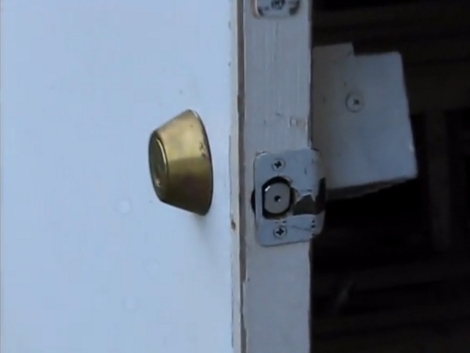
[Fileark] built an RFID entry system that uses a pretty ingenious alternative to an electronic strike plate. An electronic strike is a rather expensive hinged plate that mounts in the door frame and catches the door latch. But this system opens a set of double doors. The door without the handle is fixed in place and has a normal strike plate. But it also has a deadbolt mounted in line with that plate. When the deadbolt is extended it is flush with the strike plate, pushing the latch from the door knob back and freeing the door to swing open. This is a bit hard to put into words so watch the video after the break to clear things up.
The system uses a cheap RFID package that provides a single signal line. This line connects to an old VCR motor which turns the deadbolt. Timing is provided by a 555 chip, and the deadbolt movement is limited by a couple of switches mounted along with the motor.
Now that the unlocking mechanism has been built it would be simple to use other authentication methods for unlocking the door, like a wristwatch-based proximity system.
[youtube=http://www.youtube.com/watch?v=hpOeuOM0NBo]
















This has an elegant simpleness, thanks for sharing.
great project!
I like it but he has actually made the lock less secure. to enable the dead bolt to push out the latch he had to notch out the strike plate which makes it so anyone with a credit card can slide it in and unlock it.
nice. if I needed to get into your house, I’d just kick in your door though :D
You know, locks only really exist to keep honest people honest…..
True… that is why I have attack roosters…
re:attack roosters
Next step: RFID-enabled roosters?
I want attack roosters
I want robot chickens ;)
The electronics are neat, but I find the strike to be an incredibly creative idea.
Okay, we all want killer cocks but they can demand *so* much of our time!
LOL- I can’t wait to see the RFID-enabled roosters! Can you set up a remote controlled attack mechanism for them?
Attack roosters with lasers on their foreheads. And liquid hot magma.
Last month I got locked out from my house. But, I could access my garage via an electronic keypad.
So, I grabbed my Sawzall and a couple diamond blades.
So, you know those “cut proof” dead bolts with the floating high carbon steel insert? It lasted about 2 minutes under the mighty wrath of the Sawzall.
Point being, they have battery powered sawzalls.
“Point being, they have battery powered sawzalls.”
yep, I own a small one, its handy
Quite good project here, it’d be nice to implement it somewhere. Finally, a HaD project I understood.
I was looking for a suitable lock for a project like this a while back. This is an excelent solution- there is nothing like this lock availiable for sale that I’ve been able to find. (there are some keypad/deadbolt combinations, but no standalone locks)
The benefit to this design is that it only requires power when it changes state. Electronic strikes and any other type of electric lock (again, that I’ve been able to find) all either require power to stay locked (fail safe) or power to stay unlocked (fail secure).
I personally prefer the solenoid approach with a backup battery in case of power outages. But this is a pretty simple and neat hack.
Do you think the master rfid tag is the same as the master from a different kit?
I wouldn’t put it past the makers of a $10 kit
Have done this on 2 doors, works well. I actually extended the handle through the motor assembly so that you can lock/unlock it manually from the inside as well. Works good, and is a hell of a lot easier than hacking up the door frame and installing an electronic striker plate!
Uhm this kinda looks like a ghetto haxx. You could kick that door in easily why putting locks on it.
I even lost the last rfid key for building thats how much I care about the security.
He shouldve implant that rfid tag into his penis.
Well I found a few things from this $10 RFID kit… First its a MOD (in itself a hack of the original) from a CAR immobilizer (thats the reason for the 12V). Also the MOD’s are more for use, it’s no longer connected to a car computer (if you open it, the Yellow is connected to 2 pins, one of which is a special data pin that when used in it’s intended purpose it will send a unique serial data stream depending on which known fob was used). Also the unmarked IC is a UM3758-120AM encoded/decoder chip. The reason for the removed pins from the chip, it appears to prevent re-encoding the master chip and to control the output to instead of a unique serial stream now just an on/off stream.
Also found another mod for this device: http://home.btconnect.com/QTEKNOLOGY/rfid/RFID_new.htm